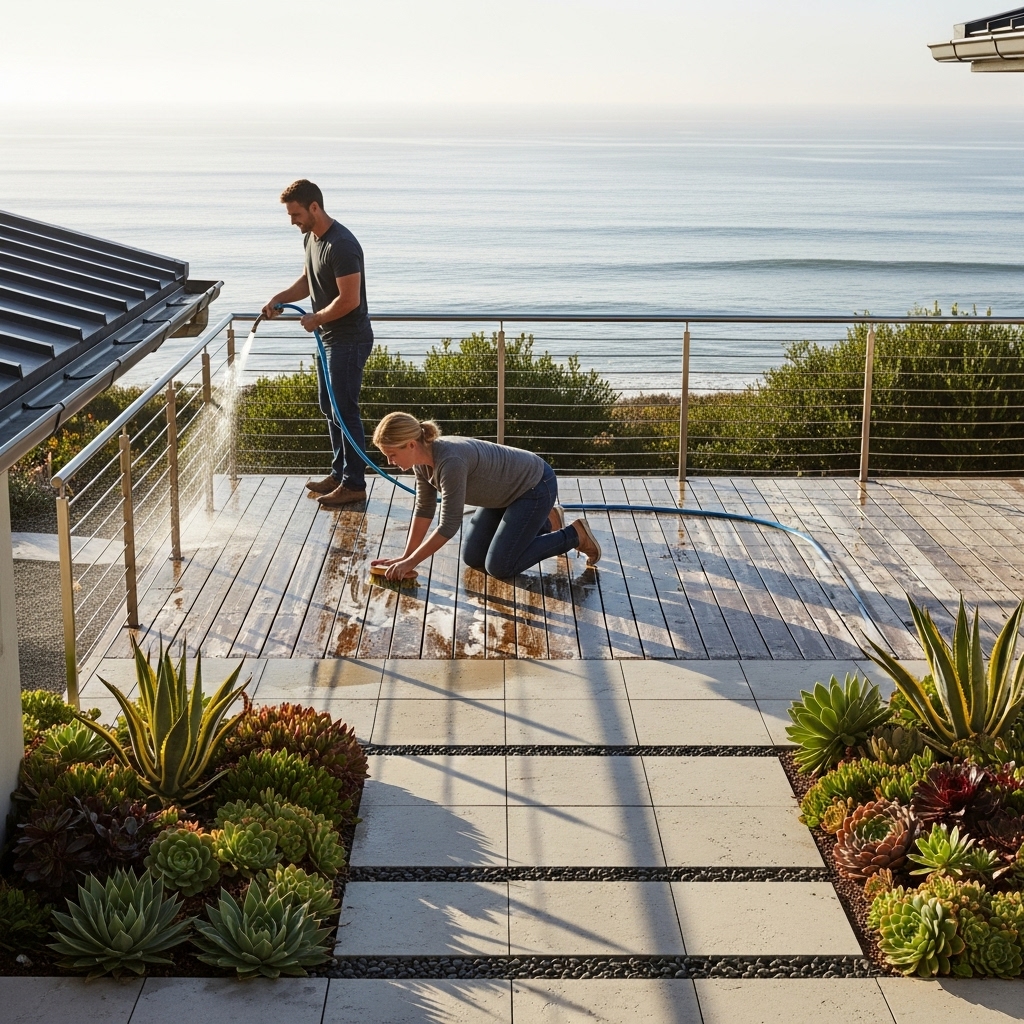
Living in Pacific Palisades offers a rare blend of canyon calm and ocean energy, and the homes here carry the mark of that environment. Sun, salt, wind, and seasonal rains shape how buildings age, and the properties that stay beautiful longest are the ones maintained with a coastal mindset. As local home builders, we see patterns in what lasts, what wears, and what pays back in comfort and longevity. Think of the following guidance as a year-round conversation with your house—a way to keep it tuned to the Palisades climate so it serves you effortlessly.
Start with the envelope, because everything inside depends on it. Coastal air introduces salt that settles on surfaces and accelerates corrosion. Plan regular rinsing of exterior metal—rails, latches, light fixtures, even door hardware—to remove salt before it sinks in. Where possible, choose finishes designed for marine environments and keep a gentle cleaning protocol ready so you don’t strip protective coatings. Wood elements benefit from a similar rhythm. Decks, soffits, and exterior trim should be cleaned, inspected, and re-sealed on a cadence that reflects your proximity to the water and your exposure to afternoon sun.
Stucco and exterior cladding deserve periodic attention. Hairline cracks can appear as buildings breathe through seasonal changes; while many are cosmetic, they can invite moisture if ignored. Walk the perimeter after the first heavy rain of the season and again in the spring. Look for staining below window sills, soft spots at trim transitions, and any caulking that looks brittle. Address small issues quickly—touched-up sealant and spot repairs prevent larger interventions later.
Roofs are the guardians you rarely see. Flat or low-slope roofs are common in modern Palisades homes, and they rely on clean drains and sound membranes. At the change of seasons, clear debris from scuppers and gutters, ensure strainers are in place, and check that water is moving to drains rather than ponding. After wind events, make a quick inspection from a safe vantage to spot lifted edges or displaced flashing. When in doubt, call a professional; it’s the highest-value maintenance you can do for the building as a whole.
Windows and doors ask for a coastal tune-up. Track systems accumulate salt and dust, which can wear on rollers and gaskets. Keep tracks vacuumed and lightly lubricated with manufacturer-approved products. Inspect weatherstripping for continuity and compression; a small gap can let in foggy air or wind-driven mist, which is felt most often in bedrooms at night. Pay attention to operable skylights too—gaskets can dry out faster under direct sun and need periodic conditioning.
Decks and balconies, those beloved outdoor rooms, live at the intersection of sun and moisture. The best maintenance blends gentle cleaning with periodic resealing of wood and vigilant care of waterproofing. For tile over waterproof membranes, monitor grout and sealant lines; for wood, mind the fasteners and shore up any areas where water tends to linger after watering or rain. If a deck drains to a hidden scupper, test it with a hose to confirm free flow before the rainy season arrives.
Drainage around the site is a constant conversation. The Palisades gets its share of gentle mists and then a sudden downpour that tests everything in an afternoon. Walk your site after the first big storm of the year. Watch how water moves at the base of slopes, along driveways, and near planters. Clear any mulch or leaves that are redirecting flow toward the house, and keep downspout outlets free and aimed at appropriate dispersal points. If water lingers near foundations, call for an evaluation before it becomes persistent.
Landscapes here love drought-tolerant plants and smart irrigation. Irrigation systems deserve seasonal tuning: check for leaks, adjust schedules to match weather, and confirm that spray patterns aren’t hitting the house. Overwatering near footings can create hydrostatic pressure and invites mildew on shaded walls. Consider mulching with materials that do not blow into drains, and maintain a modest buffer of non-combustible materials near the structure as part of a wildfire-aware landscape.
Speaking of fire, ember resistance is not a one-time feature; it’s a maintenance plan. Keep roof valleys and gutters clear of leaf litter, check that vent screens are intact and clean, and avoid storing combustible materials near the home. If you added or replaced fencing, confirm that attachments near the house are non-combustible or appropriately separated. Treat vegetation as part of the building system, shaping growth to maintain defensible space and pruning to reduce ladder fuels.
Inside the home, air quality and comfort are the rewards of consistent care. Change filters on schedule for any HVAC equipment, and remember that coastal air can load filters faster at certain times of year. Heat pumps and ERVs or HRVs need clear intake and exhaust paths; keep those grilles clean and verify that condensation drains are free of buildup. If you have radiant heat, a spring check to verify pressures and inspect manifolds is time well spent. Comfort improves, and so does efficiency.
Kitchens and baths benefit from simple habits. Run bath fans long enough after showers to exhaust moisture, and be sure they are quiet and effective so they actually get used. In kitchens, maintain range hood filters and confirm that make-up air pathways are unobstructed. If you have any specialty materials—soapstone, oiled wood, unlacquered brass—follow the manufacturer’s maintenance guidance; they reward the right care with a gorgeous patina.
Garage doors, gates, and exterior hardware live closest to the salt air and wind. Keep moving parts clean and lubricated per the manufacturer’s recommendations, and check safety sensors seasonally. For electronic locks and gate systems, protect enclosures and replace batteries on a schedule rather than waiting for them to fail. A quiet gate and a smooth garage door signal that the envelope is calm and secure.
Termites and other pests are a regional reality. A yearly inspection by a licensed professional is a wise baseline, especially for homes with extensive exterior wood or landscape features near the structure. Moisture control is part of pest control, so keep irrigation off siding, fix hose bib drips promptly, and store firewood well away from the home.
Earthquake readiness is a practical extension of maintenance in this region. Ensure heavy furniture and art are secured, consider latching systems for upper cabinets, and keep a basic emergency kit that includes water and essential supplies. Builders can help you identify anchor points and discreet reinforcement opportunities for items like tall bookcases or freestanding shelves.
Midway through each year, pause for a comprehensive walk-through with a maintenance mindset. Bring a notebook and move systematically, inside and out. Check caulking in wet rooms, look for settlement cracks at trim, toggle every light and switch, and operate windows and doors you haven’t used recently. This cadence catches small issues early and keeps you comfortable because nothing lingers long enough to become a frustration.
Documentation is the anchor that makes maintenance easy. Keep a clear record of finish schedules, paint formulas, appliance manuals, and contractor contacts. A digital folder with photos of shutoff locations, irrigation controllers, and roof access points will pay for itself the first time you need to troubleshoot on a weekend. When you do bring in a pro for service, a tidy record turns a first visit into an efficient, targeted appointment.
Renewable systems deserve attention too. If you have solar panels, schedule a safe cleaning and inspection, especially after winds bring dust from inland. Battery systems should be checked per manufacturer guidance, and EV chargers benefit from a brief inspection to ensure connections are sound. These are the kinds of details that keep modern homes running smoothly and efficiently.
Paint and interior finishes respond well to the Palisades light when they’re maintained. Touch up high-traffic areas annually, verify that tile grout in showers is sealed and intact, and pay attention to areas where condensation may appear during foggy mornings—often window corners or cool exterior walls behind furniture. Adjusting furniture placement to improve airflow sounds small, but it helps prevent musty spots and extends the life of finishes.
Finally, treat your builder as a long-term resource. Many local teams offer seasonal checkups or maintenance programs tailored to coastal conditions. Even without a formal plan, a quick call to ask about an unfamiliar stain, a draft where there shouldn’t be one, or a door that’s suddenly sticky can direct you to the right fix before frustration sets in.
How often should I clean exterior metal near the coast?
At least quarterly is a good rule of thumb, with more frequent rinsing if you’re especially close to the water or after a period of heavy wind. The goal is to remove salt before it begins to etch or corrode finishes.
What’s the best timing for roof and gutter maintenance?
Check and clear drains and gutters at the start of the rainy season and again after the first significant storm. If trees overhang the roof, more frequent checks help prevent clogs that lead to ponding or overflow.
How can I keep sliding doors operating smoothly?
Vacuum tracks regularly, wipe them with a damp cloth, and apply a light lubricant approved by the door manufacturer. Inspect weatherstripping for continuity and replace sections that have compressed or cracked under sun exposure.
Is there a coastal maintenance checklist for windows?
Yes: clean glass and frames, clear weep holes, check sealant lines, and confirm that locking mechanisms engage easily. If you notice condensation between panes, contact a professional, as it may signal a failed seal that needs attention.
How do I maintain wildfire readiness around my home?
Keep gutters free of debris, maintain a buffer of non-combustible materials near the structure, trim vegetation to reduce ladder fuels, and ensure vent screens are intact. These steps work together to reduce ember risk while preserving the landscape’s beauty.
Should I schedule professional inspections even if everything looks fine?
A yearly roof review, HVAC service, and termite inspection are wise investments, even when things appear normal. Professionals see early signs of wear that are easy to miss, allowing simple fixes before they grow into larger repairs.
Your home will reward steady, thoughtful care. If you’d like guidance tailored to your property’s location and exposure, reach out to trusted home builders who understand Pacific Palisades. A brief conversation can turn seasonal maintenance into a plan that keeps your home effortlessly comfortable year-round.

